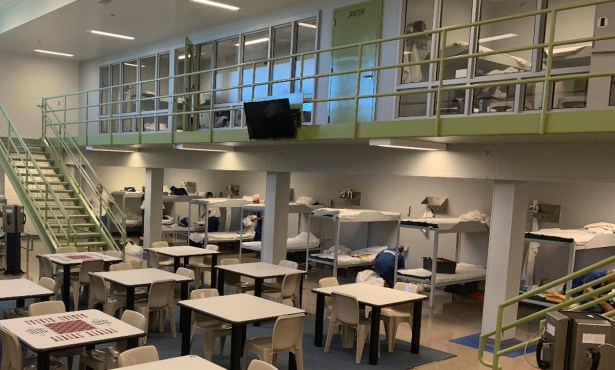The Cost of Santa Barbara Superior Court’s ‘Culture of Delay’
Supervisors Taking Hard Look at the County Budget

Public Defender Tracy Macuga didn’t exactly walk on water while telling Santa Barbara County supervisors on Monday how many County Jail inmates spend years behind bars at great taxpayer expense before ever going to trial. But when she was through, she all but got a standing ovation. “You really blew my mind,” Supervisor Das Williams told her. “This is one of the best presentations I have ever seen,” Supervisor Steve Lavagnino chimed in. “You are a force,” exclaimed Supervisor Peter Adam, the board’s most outspoken conservative.
For all the praise, Macuga’s message was both sobering and depressing. Millions of dollars are spent keeping inmates locked up before their day in court. “Justice delayed is not justice delivered,” she said, teeing off on “excessive continuance” and the “culture of delay” permeating almost every step of the criminal justice process. She talked of five clients her office represents who have been waiting in jail between three and five years. Combined, she said, these defendants have cost the county $740,000 — incarceration cost per prisoner is $42,000 annually — not including the added expenses of trial preparation, transportation to and from court, or medical attention. With more than half the inmates in County Jail awaiting trial, she said, millions of dollars that could be better spent providing mental-health services or addiction counseling are squandered warehousing defendants who more often than not need both.
There’s more, she continued. Prosecutors and defense attorneys routinely postpone cases. Important information and evidence are not shared by all parties in a timely fashion. Judges are slow getting cases on the court calendar and slower still in starting trials on time. “This is not a case for finger-pointing,” Macuga said. “We all have had a hand in it.” If the heads of various departments created a quick task force, they could make meaningful improvement, she added. One problem is that Santa Barbara Superior Court is funded by the state and not the county. Still, Macuga highlighted significant results achieved when her department worked collaboratively with county mental-health officials and prosecutors to reduce the crushing demand on the very limited bed space at the county’s acutepsychiatric-care facility by prisoners deemed “incompetent to stand trial.” The number of inmates taking up psychiatric beds has dropped by 50 percent and the length of time by 20 percent.

Supervisor Janet Wolf suggested it was no accident that such progress was made, given that the three departments involved — the Public Defender, Behavioral Wellness, and the District Attorney — were all run by women. “No offense, but you know if you want to get something done, you want women sitting around the table together,” she said. Supervisor Lavagnino noted that 11 of the county’s 22 departments were run by women, including CEO Mona Miyasato.
The supervisors are meeting three times this week to hash out a proposed budget that would have been a lot better had this winter’s disasters not inflicted a $10 million crunch to the county’s bottom line. As it is, supervisors are reviewing an early draft calling for $5.2 million in cuts and the elimination of 11 full-time positions. The bulk of those cuts would hit hardest on the Sheriff’s Office and Behavioral Wellness. The latter is looking to cut $2.35 million in services. More specifically, that’s how much has to be lopped off for expenditures on out-of-county treatment beds for those experiencing acute distress. In the past five years, costs associated with such services have increased from $2.3 million to $8.8 million, mostly because of changes in federal reimbursement formulas for people with mental illness in nursing homes. “Many more people are being put out of nursing homes,” said Behavioral Wellness Director Alice Gleghorn. Many of these, she added, have been placed in legal conservatorships and then deposited in long-term care facilities out of county. “The good news?” Gleghorn mused, looking over her notes. “There is no good news.”
The Sheriff’s Office will go less quietly into the long night of budget gloom this Friday. It’s provided a blueprint for cutting $1.6 million and eliminating 3.7 positions, more than half from the Isla Vista Foot Patrol. It has plans, however, to augment its budget by $5.5 million, enough to pay for 27 positions. However, Miyasato pointed out the Sheriff’s Office was already getting an additional $10.9 million to staff the new Northern County Jail when it opens next year. That’s more, Miyasato said, than all the other departments combined.
None of this week’s deliberations factored in the $5 million to $25 million that county bean counters expect legalized cannabis sales to generate this year. That’s because the new cannabis tax must first be approved by voters this June. Assuming the measure passes, it’s unclear how much money it will raise, given how volatile the price of pot is. Santa Barbara has more licensed cultivators than any county in the state. If and when their product hits the market, that could drive the price of pot down. It’s estimated that California currently produces eight times more cannabis than state residents consume.
Miyasato also asked the supervisors to consider an increase to the county’s sales tax. A one percent increase would generate $7.5 million. But with the pot tax on the ballot this June, none of the supervisors — with the exception of Williams — expressed any real stomach for the idea. Supervisor Lavagnino, who often functions as a key swing vote, was adamantly opposed. “I’d work against it,” he said.



